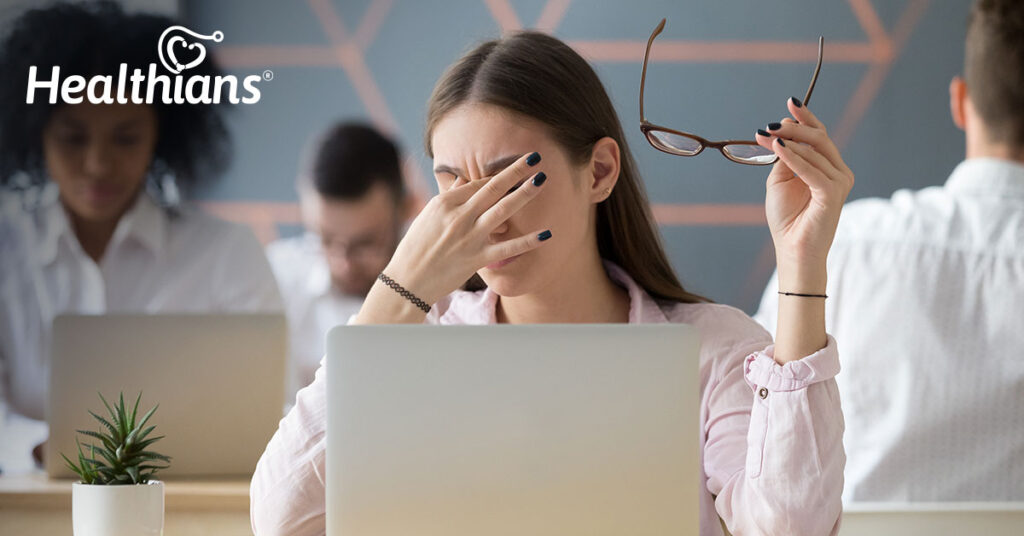Table of Contents
Introduction
As the use of digital devices such as smartphones, tablets, and laptops become more prevalent in our daily lives, many of us are experiencing eye strain. Eye strain is a common condition that occurs when the eyes get tired from prolonged use, causing discomfort, dryness, and blurred vision. It can be problematic for people who spend long hours working in front of a computer screen or using other digital devices.
Thankfully, there are several ways to reduce eye strain and keep your eyes healthy. In this blog, we will explore some tips and techniques to help you reduce eye strain and protect your vision. From adjusting the lighting in your work environment to taking regular breaks and adopting healthy lifestyle habits, there are many steps you can take to reduce the symptoms of eye strain.
Whether you’re a student, a professional, or simply someone who spends a lot of time using digital devices, this blog is for you. With a little bit of effort and awareness, you can keep your eyes healthy and comfortable, and enjoy the benefits of digital technology without any of the downsides.
Symptoms of eyestrain
- Eyes that are irritable, burning, fatigued, or sore
- Eyes that hurt
- Either dry or wet eyes
- Vision in twos or hazy
- Headache
- Neck, shoulder or back discomfort
- Light sensitivity
- Focusing and reading difficulties
- Feeling unable to maintain eye contact
Tips to reduce eyestrain
Eye yoga
Eye yoga, also known as eye exercises or eye relaxation techniques, is a series of practices aimed at improving eye health and reducing eye strain. These exercises include techniques such as palming, eye rotations, blinking, and focusing on distant objects, among others. The goal of eye yoga is to strengthen the eye muscles, improve blood circulation, and reduce eye fatigue caused by the prolonged use of digital screens and other visual stressors.
By incorporating these exercises into your daily routine, you may be able to alleviate common eye problems such as dry eyes, eye strain, and headaches.
Reduce stress
Stress and eye strain are often interconnected, and managing stress can help reduce the symptoms of eye strain. Reducing stress can significantly help in reducing eye strain. Stress and tension can lead to increased muscle tension in the eyes, resulting in eye fatigue and strain. By practising stress-reducing techniques like deep breathing, meditation, or yoga, you can calm your mind and body, reducing the strain on your eyes.
Getting enough rest and sleep can also help reduce stress levels and improve eye health. Taking regular breaks from screen time and focusing on distant objects can also help alleviate eye strain. By managing stress levels, you can reduce the risk of eye strain and other eye-related problems, improving overall eye health and well-being.
Maintain good posture
Maintaining a good posture helps reduce eye strain by preventing you from leaning too close to your computer screen or other digital devices. When you sit up straight, your eyes are positioned at a comfortable distance from the screen, reducing the need to strain your eyes to see the text or images. Additionally, good posture helps align your head and neck in a neutral position, reducing the risk of neck and shoulder pain that may contribute to eye strain.
Proper lighting
Proper lighting can make a significant difference in reducing eye fatigue and discomfort.
Here are some reasons why changing lighting can help avoid eye strain.
- Reduce Glare: Glare can cause eye strain as it makes it difficult for your eyes to focus. Adjusting the lighting and positioning of lamps can help reduce glare.
- Balanced Illumination: Uneven lighting can cause eye strain by creating areas of high contrast that are hard for your eyes to adjust to. By having balanced illumination, you can reduce eye strain and create a more comfortable environment.
- Brightness Control: By having control over the brightness of your lighting, you can adjust it to suit your task and preference. This can help to reduce eye strain and improve visual comfort.
- Colour Temperature: The colour temperature of lighting can also affect eye strain. Warm lighting can help create a relaxing atmosphere, while cool lighting can help increase focus and productivity.
Overall, changing lighting can help avoid eye strain by creating a more comfortable environment that reduces glare, provides balanced illumination, and allows you to control the brightness and colour temperature.
Blink More
Most people believe that blinking happens unconsciously. You should, however, make a conscious effort to blink more if you spend all day in front of a computer screen.
As per the expert’s advice, the blink generates moisture, which is a key component of how the eye takes care of itself.





More Stories
Thoughts as of late: on evolving, growing & that tiny voice inside
County Health Officials Report 17% Increase in Tuberculosis Cases
10 Most Nutrient-Rich Foods To Include In Your Diet